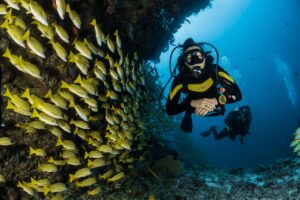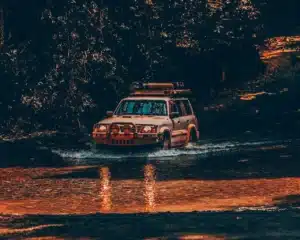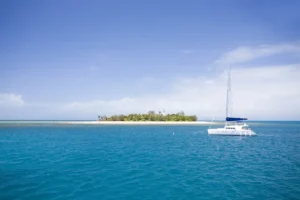Best Diving Locations in QLD
The underwater world of Australia is one of the most beautiful and diverse environments on the planet. Australia has everything from coral reefs teeming with marine life to skeleton shipwrecks, caves, wrecks, and caverns.
Queensland is full of exciting places to visit where you can try new things and create lasting memories. Bask in the sun along the seemingly endless coastline, go outback trekking, or take a hike through the lush rainforest that sweeps along the coast.
Dive and snorkel along the Great Barrier Reef, the world’s largest coral reef, and spend time exploring the tropical islands that dot this natural wonder. You’ll never be frustrated in this magnificent state.
 Steve’s Bommie, Ribbon Reefs
Steve’s Bommie, Ribbon Reefs
The Northern Ribbon Reefs of the Great Barrier Reef offer some of the best diving in Australia. Steve’s Bommie dive site begins at 33 meters and ends around 3 meters below sea level. This location is slightly off the beaten path and away from the hustle and bustle of day trips.
This location is ideal for macro photography as well as spotting large fish. The sheer number of critters is astounding. There are five different anemone fish, including the adorable Clownfish.
There are also Pipefish, Flatworms, colorful Nudibranchs, and a wide range of hard and soft corals.
Reef Sharks, Barracudas, and schools of Big-Eyed Trevally are among the larger fish found at this location. You might be lucky enough to discover pods of Minke Whales between June and July. If you are visiting Queensland, this is a must-see dive site.
Osprey Reef
Osprey Reef is a volcanic atoll located just beneath the ocean’s surface. It is about 137 miles off the coast and is easily accessible by the many liveaboards that visit the area on overnight trips from Cairns. This area has some of the best adventures available. There will be large schools of pelagic fish and sharks and visibility of over 40m. The attractive giant Potato Cod, Hammerhead Shark, and Dogtooth Tuna are the most common large fish found at this location.
Not only can you dive here during the day, but some liveaboards also offer night dives. At night, you’ll witness sleeping Parrotfish on the reef, covered in mucus that saves their scent and keeps predators at bay.
Flinders Reef, Brisbane
Even though the Great Barrier Reef is loaded with spectacular dive sites, there are additional dives on the east coast of Queensland that are not part of the stunning Barrier Reef. Flinders Reef is located 3 miles northwest of Moreton Island, outside of Brisbane, and is known as a well-kept secret among local divers.
Flinders Reef is home to more coral and fish species than any other reef on the Great Barrier Reef. Flinders Reef should be on the list of every diver visiting the area. This location is home to Mantas, Wobbegongs, Leopard Sharks, Turtles, and Whales. If you visit the western side of the reef, you might get lucky and see Whaler Sharks.
Cod Hole, Lizard Island
Some dive sites pass you by, and then some leave you with memories that will last a lifetime. Cod Hole is your dive site if you want an experience. Nothing beats staring down the massive mouth of a 150kg Potato cod, which can happen every time you visit this location.
Dive masters on your trip will usually provide a wide range of fresh fish for these large schools of Potato Fish and other opportunistic feeders to enjoy right in front of your eyes. Because the fish at this location are used to being fed by dive boats, photographers have incredible opportunities to capture once-in-a-lifetime shots. This is one of our favourite dive spots in Australia where you can see the most amazing and curious Cod’s and the graceful Sea Turtle while learning about turtles and marine life!
Wolf Rock, Rainbow Beach
Wolf Rock’s four rocky pinnacles rise from the seafloor and resemble volcanic teeth. But these stony shards in the Great Sandy Marine Park just off Rainbow Beach have evolved into a diving paradise. Swarms of marine life can be seen here, including eagle and manta rays, octopi, and schools of barracuda, as well as one of the few mating grounds for the critically endangered grey nurse shark.
Leopard sharks may accompany you in the summer, and humpback whales may accompany you in the winter. If that isn’t enough, its waters are home to three turtles: loggerhead, green, and hawksbill, which swim among the corals and tropical fish.
Moreton Island
Dive Moreton Island if you want a diverse diving experience. It’s the closest dive site to Brisbane, the state capital, and it’s a popular diving destination, but there’s plenty to go around. Flinders Reef, located north of the island, is a collection of rocky stacks, ledges, and caves encrusted with luminescent coral. You won’t be alone as you slalom through its rugged underwater landscape; stingrays, reefs, wobbegong sharks, and mantas are regular visitors.
Mooloolaba Reefs
The Mooloolaba Reefs are a coral wonderland up the coast from Brisbane, with rocky outcrops, submerged canyons, rugged ledges, and yawning tunnels all covered in a layer of kaleidoscopic corals. As you explore the crannies and nooks, you will be passed by rays, wobbegong sharks, and turtles.
The boulders and rocks also provide a feast of life within them, providing shelter for crayfish, slipper lobsters, and starfish; you will be spying on their surfaces for glimpses of various exotic marine creatures. Furthermore, because of their proximity to the southern tip of the wildly popular Great Barrier Reef, you may have these dive sites all to yourself.
Lady Musgrave Island
The Southern Great Barrier Reef is famous worldwide for its pristine, unspoiled beauty and scuba diving. Turtles, Manta rays, and migrating Humpback Whales are all symbols of this area. Lady Musgrave Island is a pristine paradise for a day trip waiting to be discovered. It is located along the Southern Great Barrier Reef and close to Brisbane.
Scuba divers can meet with manta rays, moray eels, and reef sharks on the Southern Barrier Reef. Snorkelers can swim with schools of tropical reef fish, giant rainbow-colored parrotfish, and turtles that come ashore to lay their eggs during summer. During the breeding season, the waters teem with Green and Loggerhead turtles.
Stradbroke Island
The warmer months attract a diverse range of marine life, including large groups of Manta Rays. Stradbroke Island, located 30 kilometers off the coast of Brisbane, is ideal for a day trip or a longer stay with a tropical island feel. The main diving attraction on the island is the Moreton Marine Park, which is home to one of Australia’s top ten dive sites, Manta Bommie.
Cherubs Cave is a macro-dream photographer with an incredible collection of critters that call this dive site home. Expect to see Eagle Rays, Leopard Sharks, Stingrays, Turtles, Wobbegong Sharks, Pelagic Fish, and Shovelnose Rays. It also has a large population of Gray Nurse Sharks, Anemones, and Clownfish.
HMAS Brisbane
The HMAS Brisbane is an ex-Navy destroyer sunk in 2005 to make an artificial reef 5.5 miles northwest of Mooloolaba, Queensland. The recorded 1000-plus species that have made this wreck their home are why this dive site is so epic. Many different types of hard and soft corals, stunningly colored Nudibranchs, Octopus, Sea Snakes, sea stars, Turtles, Sharks, Flatworms, Moray Eels, Grouper, and much more can be found.
This dive site is ideal for open-water divers who want to try their first wreck dive.
SS Yongala Wreck
The SS Yongala Wreck is on the bucket list of many divers. The Yongala sank 55 miles off the coast of Townsville in 1911. Unfortunately, all 122 people on board died in this tragedy, which went unnoticed for over 50 years. The wreck is now considered a national heritage site and an incredible artificial reef with stunning marine life that rivals almost any other wreck site off Queensland’s coast.
There are giant Groupers, Manta Rays, Eagle Rays, Barracuda, Bull Sharks, Pelagics, Turtles, and Olive Sea Snakes, all of which are friendly and appear to get along well with divers visiting the area. If you plan on visiting this dive site, keep in mind that there are strong currents on the surface, so some diving experience and good physical fitness are required.
Agincourt Reef
Some of the world’s most well-known and fascinating dive sites can be found on Agincourt Reef. There are plenty of coral gardens and caves to explore and brightly colored fish and marine plant life to see. There are approximately 21 dive sites at Agincourt Ribbon Reef. You can expect to see a lot of wildlife and have some genuinely unforgettable life experiences that you will memorize and cherish for the rest of your life.

 Steve’s Bommie, Ribbon Reefs
Steve’s Bommie, Ribbon Reefs


